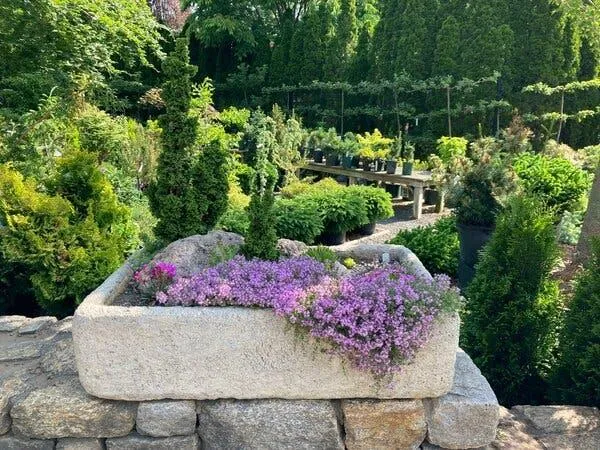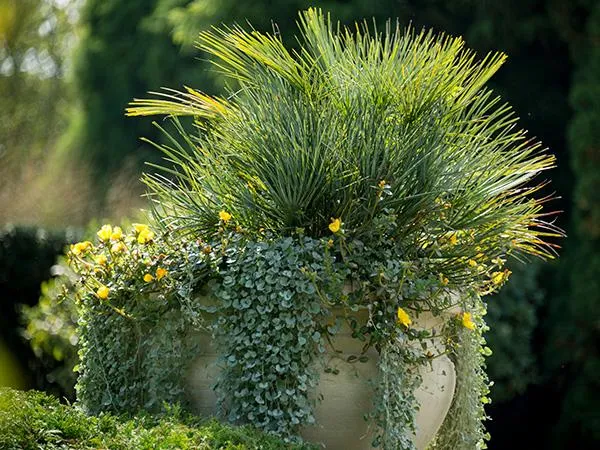Everything You Need to Know About Cascading Flowers in Pots
If you’re looking to add some vibrant color and movement to your outdoor planters and pots, cascading flowers may be just what you need. In this article, I’ll cover all the basics on growing trailing blooms in containers from plant selection and care to design tips. By the end, you’ll have everything you need to create stunning cascades of color.
Choosing the Right Cascading Flowers
There are many fantastic flowering vines and spillers to choose from when it comes to cascading plants for pots. Here are some top options to consider:
- Petunias – These bedding plants come in a huge range of colors and will trail beautifully over the edges of pots. They bloom non-stop from spring through fall. Petunias are very hardy.
- Ivy Geraniums – Similar to petunias, ivy geraniums produce an abundance of colorful flowers. They also have attractive dark green foliage. These tend to be more heat and drought tolerant than petunias.
- Million Bells – Also called calibrachoa, million bells bear small round blooms in a multitude of colors. They spread rapidly and will add lots of texture and pops of color.
- Verbena – Available in pinks, purples, reds and white, verbena blooms generously. It has a more trailing habit than ivy geraniums or petunias.
- Vinca – The perfect ground cover vine, vinca comes in both green and variegated leaf varieties as well as a range of flower colors. It thrives in partial shade.
Creating the Right Conditions
For cascading plants to thrive, you’ll need to provide the right growing environment. From my experience, focus on the following:
- Choose a container at least 12-16 inches wide to allow plenty of room for trails of blooms to spill over the edges.
- Use a soil-less potting mix designed for containers. It drains well while still retaining moisture.
- Group pots together to create the illusion of a larger planted area. This helps retain warmth and shields plants from wind.
- Give pots at least 6 hours of direct sun per day for maximum blooming. Morning sun is ideal to avoid scorching afternoon rays.
- Water regularly, allowing the soil to dry slightly between waterings. Use a water-soluble fertilizer every 2-3 weeks during the growing season.
Easy Care After Planting
Once your cascading flowers are planted, maintenance is simple. The key is to:
- Pinch back stems regularly to encourage bushy growth and more prolific blooming. This is especially important with ivy geraniums.
- Deadhead spent flowers to prolong the bloom time. Cut off faded flowers down to the next leaf or stem joint.
- Watch for pests like aphids or spider mites in long dry spells and treat promptly if spotted.
- Mulch around the pots with decorative bark to retain moisture and suppress weeds.
- Fertilize monthly through summer for a continual display of colorful flowers.
Designing Stunning Cascades
With a selection of trailing bloomers and the right conditions, you’ll be ready to design show-stopping cascades of color. Here are some design tips:
- Choose a mix of 3-5 trailing plants with complementary or contrasting colors.
- Plant taller varieties towards the center of containers and shorter spillers towards the edges.
- Emphasize height and texture differences by mixing flower shapes and foliage textures.
- Consider using hanging baskets in addition to taller pots and urns for multiple viewing angles.
- Add other trailing plants like ivy, sweet potato vine or nasturtium for lush, jungle-like effects.
Amazingly, with barely any effort beyond watering, your pots will spill forth with wave after wave of blooms. Who could ask for anything more?
Dealing with Challenges
Like any garden, cascading container displays do face occasional hurdles. Here are some issues you may encounter from time to time along with solutions:
Lack of blooms:
If flowers seem sparse, try boosting fertilizer, providing at least 6 hours of sun daily, and pinch back stems regularly to encourage branching.

Leggy growth:
Especially an issue with petunias, prevent lanky stems by pinching back often when plants are young or provide support with garden stakes.
Pests like aphids:
Isolate and remove infected parts of plants. Spray with insecticidal soap or neem oil as needed following label directions.
Too much rain or overwatering:
Too much moisture can cause stem rot. Improve drainage if needed and give pots a chance to dry out slightly between waterings.
With a little TLC, you can sort out virtually any issues that arise. Sometimes it just takes patience and experience with different plant mixes before achieving a picture-perfect cascading pot!
Inspiration for Unique Displays
For some design inspiration beyond the basics, check out these great ideas:
- Layer different heights of pots on stepped terraces or winding staircases.
- Play with textures by pairing trailing blooms with vines like morning glory or sweet peas.
- Train flowering vines up and over arbors, fences or pergolas for an eye-catching vertical element.
- String twinkle lights through pots and hanging baskets after dark for a magical effect.
- Dot pots with edibles like strawberries, nasturtiums or thyme for an tasty sensory experience.
The possibilities are endless when it comes to using cascading flowers creatively. With some experimentation, you’re bound to come up with striking combinations that become your signature style.

Frequently Asked Questions
Hopefully this article covered everything you need to know, but here are a few more questions people commonly ask:
How long will pots of cascading flowers last?
With good care, a planting can provide color for 3-6 months or even longer depending on the variety and growing conditions.
Can I bring potted cascades indoors in winter?
While it’s best to move tender plants inside before frost, many trailing bloomers like petunias, verbena or vinca can survive indoors on a sunny windowsill with minimal care.
Do cascading pots need staking or support?
Generally no, but lankier growers like nasturtiums or morning glories may appreciate some trellising behind the pots for maximum drama.
How do I keep pots from drying out fast?
Use generous mulch, group containers closely together, and water in the morning to allow time for drying before evening.

I hope this guide has given you everything you need to create your own backyard oasis bursting with the colors, scents and joy of cascading flowers spilling out of pots! Let me know if any other questions come up.
Important Considerations for Choosing Cascading Flowers for Pots
| Flower Type | Growth Habit | Water Needs | Sun Exposure | Best Uses |
|---|---|---|---|---|
| Petunias | Drape over pots | Daily watering | Full sun | Hang pots, window boxes |
| Ivy | Creep along edges | Water weekly | Part shade | Cover walls, trellises |
| Begonias | Spill over sides | Daily misting | Part shade | Hanging baskets, container gardens |
| Lantana | Trail over edges | Water every 2-3 days | Full sun | Container gardens, rock walls |
| Bacopa | Spreading growth | Water weekly | Full sun to part shade | Hanging baskets, container gardens |
FAQ
-
What type of flowers can I grow in pots?
There are lots of choices for cascading flowers in pots. Basically, petunias, begonias, and geraniums work well. Sort of flowering vines like morning glories and nasturtiums are also nice options to try.
-
How do I care for cascading flowers in pots?
You’ll need to water cascading flowers in pots regularly, perhaps every day depending on the weather. At the same time, be careful not to overwater them. It’s also important to fertilize them weekly during the growing season. Possibly use a water-soluble plant food.
-
When should I plant cascading flowers?
The ideal time to put cascading flowers in pots is in late spring or early summer after the last expected frost. Maybe plant them a little earlier if you’re in a warmer climate. Seems experts suggest mid to late May in many areas. Be sure not to plant them too hastily though – it’s better to wait for nighttime temperatures to stay above 50 degrees Fahrenheit.
-
How do I get my cascading flowers to drape nicely?
To get cascading flowers in pots to drape well, give them something to cascade down from or grow over the edges of taller pots. Appears using hanging baskets or tall containers works nicely. You can also tie the stems of flowers gently to stakes or strings to guide them. Supposedly refresh the ties weekly as the plants grow.
-
Will cascading flowers continue blooming all summer?
Fortunately, many types of cascading flowers will keep pumping out blossoms throughout the warmer months if cared for properly. On the other hand, some varieties may bloom less heavily towards the end. As a rule of thumb, petunias, begonias, and fuchsias usually deliver color from June until early fall. Always check plant tags for specific varieties’ bloom times though.
-
What can go wrong with cascading flowers?
Common problems include diseases, insects, and lack of care. Diseases to watch out for are powdery mildew and leaf spots. Pests like aphids can be a hassle too. Is it worth contacting your garden center about organic remedies if issues arise? Improper watering or fertilizing can also ruin your hard work. But with diligence bugs and sicknesses need not destroy such dazzling displays!
-
Do cascading flowers prefer sun or shade?
Most cascading flowers totally love full sun. I mean, they were practically made for sunny container gardens! Some, however, will tolerate partial shade – like petunias and wave petunias. Quoting the pros, a minimum of six hours of direct sun daily is best. Less than that could cause them to become lank or not flower as much. Perhaps try an increasingly shadier spot as summer drags on if your area bakes in August heat.
-
What else can I grow with cascading flowers?
Cascading flowers pair beautifully with other bloomers like calibrachoa, lobelia, impatiens, and vinca in mixed containers. Some leafy filler like purple calibrachoa or green ivy provides lovely contrast. Haven’t tried adding strawberries, basil or thyme for a scented edible element? Maybe tossing in shocking annuals like orange marigolds or blue angelonia takes the combo to new heights! Take the experts’ advice – let your imagination run wild with color mixes.

